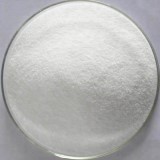 |
Sodium Dodecyl Sulfate or Sodium Lauryl Sulfate USP NF Grade Supplier Exporter Manufacturers' Representative |
Email: info@ammol.org |
Call Toll Free +1-855-552-6665 |
Sodium Dodecyl Sulfate or Sodium Lauryl Sulfate
CAS Number: 151-21-3
Molecular Formula: NaC12H25SO4
Molecular Weight: 288.37

Sodium Dodecyl Sulfate or Sodium Lauryl Sulfate
Sodium Lauryl Sulfate USP NF Grade Specifications
Sulfuric acid monododecyl ester sodium salt.
Sodium monododecyl sulfate CAS 151-21-3
Sodium Lauryl Sulfate is a mixture of sodium alkyl sulfates consisting chiefly of sodium lauryl sulfate [CH3(CH2)10CH2OSO3Na]. The combined content of sodium chloride and sodium sulfate is not more than 8.0 percent.
Identification:
A: Ignite about 500 mg at 800 until the carbon is consumed: the residue dissolved in 10 mL of water responds to the tests for Sodium.
B: A solution (1 in 10) after acidification with hydrochloric acid and gentle boiling for 20 minutes, responds to the tests for Sulfate.
Alkalinity: Dissolve 1.0 g in 100 mL of water, add phenol red, and titrate with 0.10 N hydrochloric acid: not more than 0.60 mL is required for neutralization.
Heavy metals: 0.002%.
Sodium chloride: Dissolve about 5 g, accurately weighed, in about 50 mL of water. Neutralize the solution with 0.8 N nitric acid, using litmus paper as the indicator, add 2 mL of potassium chromate, and titrate with 0.1 N silver nitrate. Each mL of 0.1 N silver nitrate is equivalent to 5.844 mg of NaCl.
Sodium sulfate:
Lead nitrate solution: Dissolve 33.1 g of lead nitrate in water to make 1000 mL.
Procedure: Transfer about 1 g of Sodium Lauryl Sulfate, accurately weighed, to a 250-mL beaker, add 35 mL of water, and warm to dissolve. To the warm solution add 2.0 mL of 1 N nitric acid, mix, and add 50 mL of alcohol. Heat the solution to boiling, and slowly add 10 mL of Lead nitrate solution, with stirring. Cover the beaker, simmer for 5 minutes, and allow to settle. If the supernatant is hazy, allow to stand for 10 minutes, heat to boiling, and allow to settle. When the solution is almost to a boiling point, decant as much liquid as possible through a 9-cm filter paper (Whatman No. 41 or equivalent). Wash four times by decantation, each time using 50 mL of 50 percent alcohol, and bring the mixture to a boil. Finally, transfer the filter paper to the original beaker, and immediately add 30 mL of water, 20.0 mL of 0.05 M EDTA disodium, and 1 mL of ammonia-ammonium chloride buffer. Warm to dissolve the precipitate, add 0.2 mL of eriochrome black and titrate with 0.05 M zinc sulfate. Each mL of 0.05 M EDTA disodium is equivalent to 7.102 mg of Na2SO4.
Unsulfated alcohols: Dissolve about 10 g, accurately weighed, in 100 mL of water, and add 100 mL of alcohol. Transfer the solution to a separator, and extract with three 50-mL portions of solvent hexane. If an emulsion forms, sodium chloride may be added to promote separation of the two layers. Wash the combined solvent hexane extracts with three 50-mL portions of water, and dry with anhydrous sodium sulfate. Filter the solvent hexane extract into a tared beaker, evaporate on a steam bath until the odor of solvent hexane no longer is perceptible, dry the residue at 105C for 30 minutes, cool, and weigh. The weight of the residue is not more than 4.0% of the weight of the Sodium Lauryl Sulfate taken.
Total alcohols: Transfer about 5 g, accurately weighed, to an 800-mL Kjeldahl flask, and add 150 mL of water, 50 mL of hydrochloric acid, and a few boiling chips. Attach a reflux condenser to the Kjeldahl flask, heat carefully to avoid excessive frothing, and then boil for about 4 hours. Cool the flask, rinse the condenser with ether, collecting the ether in the flask, and transfer the contents to a 500-mL separator, rinsing the flask twice with ether and adding the washings to the separator. Extract the solution with two 75-mL portions of ether, evaporate the combined ether extracts in a tared beaker on a steam bath, dry the residue at 105 for 30 minutes, cool, and weigh. The residue represents the total alcohols, and is not less than 59.0% of the weight of Sodium Lauryl Sulfate taken.
We also supply Sodium Dodecyl Sulfate or Sodium Lauryl Sulfate BP Ph Eur Grade.
Please visit SDS Safety Data Sheet of or Sodium Lauryl Sulfate or Sodium Dodecyl Sulfate Suppliers.
American Molecules, also known as ammol.org is a distributor, supplier and manufacturers' representative of all types of Pharmaceuticals, Functional Ingredients, Excipients and Specialty Chemicals in Texas USA. Our principals manufacture supply and export USP NF BP, Ph Eur, etc grades of chemicals pure and reagent grade, mineral fortifiers, FCC food grade. Tailor made particle size and customized specifications are offered. The principal's facility is having one or more of the certifications like FDA approval and GLP, cGMP, ISO9001, ISO14001, ISO/IEC 17025, ISO22000, FSSC 22000, ISO45001, FSSAI, Kosher, HALAL, COPP, WHO-GMP certified and Written Confirmation (WC) for export to Europe is available. The manufacturers suppliers and exporters observe WHO Good Manufacturing Practices and Good Laboratory Practices.





Suppliers and Manufacturers' Representative:

9910 Bent Oak Dr
Houston, TX 77040, USA
Call Toll Free: 1-855-55-AMMOL 1-855-552-6665
Email: info@ammol.org